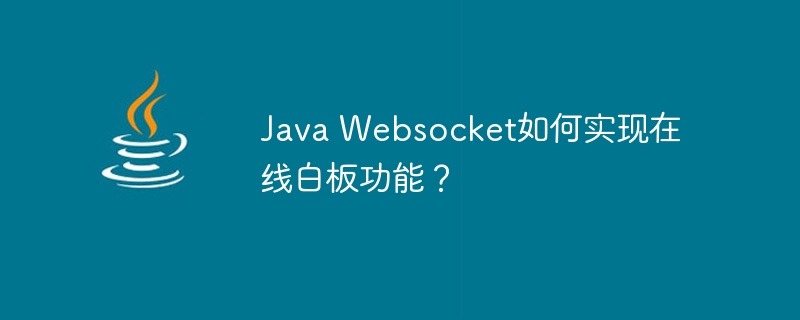

How does Java Websocket implement the online whiteboard function?
In the modern Internet era, people are paying more and more attention to the experience of real-time collaboration and interaction. Online whiteboard is a function implemented based on Websocket. It enables multiple users to collaborate in real-time to edit the same drawing board and complete operations such as drawing and annotation. It provides a convenient solution for online education, remote meetings, team collaboration and other scenarios.
1. Technical background
WebSocket is a new protocol provided by HTML5. It implements full-duplex communication on the same TCP connection, effectively solving the limitations of the request-response mode of the HTTP protocol. . WebSocket is based on an event-driven programming model and uses standardized APIs to make writing real-time communication applications simple and efficient.
2. Implementation steps
<dependency>
<groupId>javax.websocket</groupId>
<artifactId>javax.websocket-api</artifactId>
<version>1.1</version>
</dependency>
<dependency>
<groupId>org.glassfish.tyrus</groupId>
<artifactId>tyrus-server</artifactId>
<version>1.17</version>
</dependency>
<dependency>
<groupId>org.glassfish.tyrus</groupId>
<artifactId>tyrus-container-grizzly-server</artifactId>
<version>1.17</version>
</dependency>import java.io.IOException;
import javax.websocket.Endpoint;
import javax.websocket.EndpointConfig;
import javax.websocket.MessageHandler;
import javax.websocket.Session;
import javax.websocket.server.ServerEndpoint;
@ServerEndpoint(value = "/whiteboard")
public class WhiteboardEndpoint extends Endpoint {
@Override
public void onOpen(Session session, EndpointConfig config) {
session.addMessageHandler(new MessageHandler.Whole<String>() {
@Override
public void onMessage(String message) {
// 处理收到的消息
System.out.println("Received message: " + message);
// 广播消息给所有连接的客户端
session.getOpenSessions().forEach(s -> {
try {
s.getBasicRemote().sendText(message);
} catch (IOException e) {
e.printStackTrace();
}
});
}
});
}
}import javax.servlet.annotation.WebServlet;
import org.glassfish.tyrus.server.Server;
@WebServlet(name = "WhiteboardServlet", urlPatterns = {"/whiteboard/*"})
public class WhiteboardServlet extends javax.servlet.http.HttpServlet {
private static final long serialVersionUID = 1L;
private static final int PORT = 8080;
private static Server server;
@Override
public void init() {
server = new Server("localhost", PORT, "/websocket", null, WhiteboardEndpoint.class);
try {
server.start();
} catch (Exception e) {
e.printStackTrace();
}
}
@Override
public void destroy() {
server.stop();
}
}<!DOCTYPE html>
<html>
<head>
<title>Online Whiteboard</title>
<script type="text/javascript">
var socket = new WebSocket("ws://localhost:8080/websocket/whiteboard");
socket.onmessage = function(event) {
// 收到消息时的处理逻辑
console.log("Received message: ", event.data);
};
function send(message) {
// 发送消息给服务器
socket.send(message);
}
</script>
</head>
<body>
<!-- 在这里放置绘图相关的HTML节点 -->
<canvas id="canvas"></canvas>
<button onclick="send('Hello, WebSocket!')">Send Message</button>
</body>
</html>3. Function expansion
Based on the above foundation, we can further expand the functions of the online whiteboard.
4. Summary
This article introduces how to use Java WebSocket to implement the online whiteboard function and how to interact with the front-end page. Through real-time collaboration and interaction, we can allow multiple users to collaboratively edit on the same drawing board, thereby improving collaboration efficiency and experience. I hope readers can use this article to have a certain understanding of Java WebSocket and be able to apply it to actual projects.
The above is the detailed content of How does Java Websocket implement online whiteboard function?. For more information, please follow other related articles on the PHP Chinese website!
